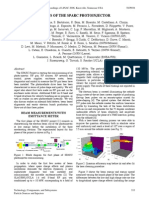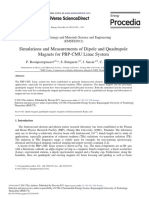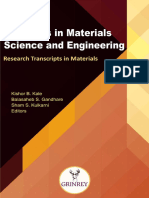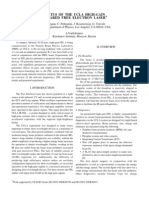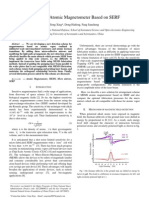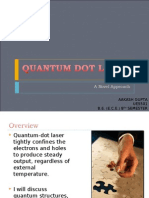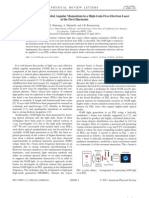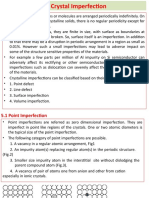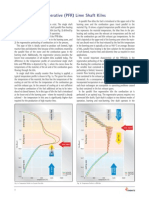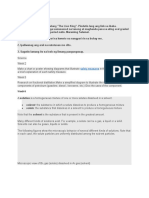Investigation of X-Ray Harmonics of The Polarized Inverse Compton Scattering Experiment at Ucla
Investigation of X-Ray Harmonics of The Polarized Inverse Compton Scattering Experiment at Ucla
Uploaded by
Particle Beam Physics LabCopyright:
Available Formats
Investigation of X-Ray Harmonics of The Polarized Inverse Compton Scattering Experiment at Ucla
Investigation of X-Ray Harmonics of The Polarized Inverse Compton Scattering Experiment at Ucla
Uploaded by
Particle Beam Physics LabOriginal Title
Copyright
Available Formats
Share this document
Did you find this document useful?
Is this content inappropriate?
Copyright:
Available Formats
Investigation of X-Ray Harmonics of The Polarized Inverse Compton Scattering Experiment at Ucla
Investigation of X-Ray Harmonics of The Polarized Inverse Compton Scattering Experiment at Ucla
Uploaded by
Particle Beam Physics LabCopyright:
Available Formats
Proceedings of 2005 Particle Accelerator Conference, Knoxville, Tennessee
INVESTIGATION OF X-RAY HARMONICS OF THE POLARIZED
INVERSE COMPTON SCATTERING EXPERIMENT AT UCLA
A. Doyuran, 0. Williams, R.J. England, C. Joshi, J. Lim, J.B. Rosenzweig, S. Tochitsky, G. Travish
UCLA Department of Physics and Astronomy, 405 Hilgard Ave., Los Angeles, CA 90095.
Abstract then recollimated by an identical PMQ system. The
An Inverse Compton Scattering (ICS) experiment, electron beam focusing and recollimating systems consist
which will investigate nonlinear properties of scattering of 5 equal strength and length PMQs each, set up as a
utilizing a terawatt CO2 laser system with various modified FF-DD-F triplet.
polarizations, is ongoing at the UCLA Neptune The high power CO2 laser is focused by an off-axis
Laboratory. When the normalized amplitude of the parabolic mirror with a 12.7 cm diameter and 17 cm focal
incident laser's vector potential ao is larger than unity the length. Since the divergence of the scattered photons is
scattering occurs in the nonlinear region; therefore, higher quite large (-I/, where 28) it is necessary to place the
harmonics are also produced. ICS can be used, e.g., for a detector (soft X-ray camera and/or micro-channel plate)
polarized positron source by striking a thin target (such as very close to the IP. This requires bending the electron
tungsten) with the polarized X-rays. As such, it is critical beam immediately after the recollimating PMQ system, in
to demonstrate the production of polarized scattered a very short bending radius. To this end, we have designed
photons and to investigate the ICS process as it enters the and built a permanent magnet dipole (PMD) with a -60
nonlinear regime. We present the description of the mm bending radius for this purpose.
experimental set up and equipment utilized, including
diagnostics for electron and photon beam detection. We Table 1: Electron and Laser Beam Parameters
present the current status of the experiment. Parameter Value
Electron Beam Energy 14 MeV
INTRODUCTION Beam Emittance 5 gm
Electron Beam Spot size (RMS) 25 m
Inverse Compton Scattering (ICS) is becoming an
effective source for producing third generation light Beam Charge 300 pC
source quality X-rays using low energy electron beams.
Bunch Length (RMS) 4 ps
Laser Beam Size at IP (RMS) 25 m
For these light sources, and in HiEP applications such as -
CO2 Laser Wavelength 10.6 m
colliders and polarized positron sources [1], an
understanding of the physics of nonlinear and polarization CO2 Laser Rayleigh Range 0.75 mm
dependent ICS is required. CO2 Laser Power 500 GW
The UCLA Neptune laboratory is an appropriate test CO2 Laser Pulse Length 200 ps
bed for these experiments. Such experiments can utilize
the existing terawatt CO2 laser ( L 10.6 m), which, Table 2: Calculated Scattered Photon Parameters
when strongly focused, may yield a normalized vector Parameter Head-on Transverse
Scattered photon wave- 5.3 nm 10.7 nm
potential, a eA0 /mec2 1 where Ao is vector potential length (fundamental)
of the laser field. In this regime, non-linear effects enter Scattered photon energy 235.3 eV 117.7 eV
strongly in the interaction. The Neptune RF photo-injector Scattered photon pulse 10 ps 10 ps
gun and linac can deliver high quality electron beams duration (FWHM)
having 14 MeV energy, 300 pC per bunch of 10 ps Interaction time 5 ps 0.33 ps
FWHM. Table 1 shows the designed electron and laser # of periods that electrons 283 10
beam parameters and Table 2 shows the calculated see (No)
scattered photon beam parameters for head on and # of photons emitted per 3.34 0.11
transverse scattering cases [2-3]. Since both laser and electron (N)
electron beam require hard focusing into the IP, we have Total # of photons 6.3.109 2.108
developed and built permanent magnet quadrupoles Half Opening Angle 2.7 mrad 15 mrad
(PMQs) with 6 mm clear aperture. Even with a short Bandwidth 0.35% 10 %
distance to focus, the laser divergence makes head on
scattering unfeasible. Therefore we have designed the
scattering in transverse (900) geometry. Permanent Magnet Quadrupole (PMQ)
The ICS experiment requires that we produce a 25 m
EXPERIMENTAL SET UP (RMS) electron beam size at the IP. The ultra-short focal
Figure 1 shows the schematic of the experimental set up length quadrupoles which allow this type of focus consist
in the ICS interaction chamber. The electron beam is of four NdFeB magnet cubes with 1.21 T resonant field,
focused by the PMQ system to the interaction point, and hyperbolic iron tips and hexagonal iron yoke for flux
2303 0-7803-8859-3/05/$20.00 ©2005 IEEE
Proceedings of 2005 Particle Accelerator Conference, Knoxville, Tennessee
return (Fig. 2). The hyperbolic iron tips are held in place The PMD, shown in rendered CAD format in Fig. 3, is
by an aluminum keeper which determines the geometric designed such that the electron beam is bent 900 vertically
axis. The magnets are pushed towards the geometric axis over a fairly wide range of energies. The nominal design
by a screw to assure that they are equidistant from the energy bend radius is 60 mm. The magnet gap is 16 mm,
center. This quadrupole produces -1 15 T/m gradient. and the magnetic material thickness is 30 mm with a
Radia 3D magnetostatic simulations [4-5] are in good magnetization of 1.32 T. This geometry provides the
agreement with the measured gradient using a Hall probe. needed 0.78 T magnetic field inside the gap. The magnet
The magnetic axes of the PMQs are measured using a and iron yoke is circularly cut to optimize the clearance
pulse wire measurement [6] and because the machining is for the scattered beam.
done by electric discharge machining (EDM) we found Radia simulations predict the measured fields very well.
the magnetic axis to be directly on the geometric axis To accommodate beam off-axis, off-angle and off-energy
within the accuracy of wire radius (25 m). operation we have placed the PMD on a remote controlled
vertical mover. Thus the PMD can bend electron beams
with energies ranging from 12 MeV to 14 MeV with
various offsets in transverse positions and angles at the
entrance of the PMD.
Soft X-ray
nIP/ Mcdiagnostics
PMQ system PMD
Off axis_ on
parabolic, C02 LASER
mirror
Figure 1: Focusing system for the electron and laser
beams. NdFeB
Magnet
Figure 3: Compact dipole using permanent magnets.
IP Diagnostics
Dealing with 25 m (RMS) beams at the IP requires
careful imaging and alignment. The 900 scattering
geometry makes it difficult to image both electron and
laser beams simultaneously. We designed and
manufactured a pyramid shaped diagnostic (Fig. 4) with
optically polished surfaces and sharp edges.
U CCD
Figure 2: PMQ design using 4 cube magnets, hyperbolic Graphite
pole tips and aluminum keepers. sprayed
surface
Permanent magnet Dipole (PMD) e beam
The typical opening angle of the scattered photon beam
is -1/ which requires having the soft-X-ray detector .................
....................................
array very close to the IP. In order to bend the electron .........................................
beam away from this detector in as short a distance as
possible, immediately after the recollimating PMQs, a Figure 4: The IP imaging diagnostic "pyramid".
permanent magnet dipole (PMD) has been designed with
bend angle of 900. Transverse alignment is established by imaging the
OTR from the electron beam and "sparking" from the
0-7803-8859-3/05/$20.00 ©2005 IEEE 2304
Proceedings of 2005 Particle Accelerator Conference, Knoxville, Tennessee
C02 laser hitting a graphite layer applied to one pyramid for 900 case. The development of calculations for circular
surface. Simultaneous imaging two of the pyramid faces polarization with 900 is now underway.
with a CCD allows for spatial alignment of the two
beams. Temporal synchronization is established using a ELECTRON BEAM SIZE
germanium crystal oriented at 450 as a "gate". Incident MEASUREMENT AT IP
beam electrons cause the germanium to become opaque to
10.6 m radiation and block the perpendicularly incident We started running the experiment just recently and
CO2 beam. Measurement of the corresponding transmitted accomplished a measurement of the electron beam size at
intensity of the laser reveals the relative timing between the IP using a YAG crystal. Preliminary measurement of
the beams, allowing for tuning of the arrival time at the the RMS beam size at the IP is about 40-50 m for an 11
interaction point. MeV electron beam which is not fully optimized. Our aim
is to reduce the beam size to 25 m at 14 MeV. An
increase in energy will reduce the emittance due to the
(a) Schottky effect in the RF gun yielding a smaller spot size
10 at the IP.
40- 4 3
dE c, _4 3
dw-- 2
>10 43
0 g I
Figure 6: Electron beam image at the IP. RMS beam size
is 40-50 m.
CONCLUSION
We have presented the details of the ongoing nonlinear
3 x10
- 43 polarized ICS experiment including design and
calculation issues, and present status. The beam size
dE 2 >10
measurements at the IP have proven the effectiveness of
-d 43
the PMQ focusing system, and represent a factor of 3
1> -
improvement over the original electromagnets.
REFERENCES
[1] T. Omori et. al., NIM A 500 (2003) 232-252
[2] S. Ride, E. Esarey, M Baine, Pyhs. Rev. E Vol 52,
p5425 (1995)
[3] A. Doyuran, et.al., Study of X-ray Harmonics of the
Polarized Inverse Compton Scattering Experiment at
Figure 5: Intensity plot of (a) and (b) polarizations at UCLA, AAC 2004 Proceedings.
the first harmonic. The screen location is set at z= , and x [4] PAC97 Conference, Vancouver, May 1997: P.
and y are in mm units. Elleaume, 0. Chubar and J. Chavanne, "Computing
3D Magnetic Fields from Insertion Devices" (9P27)
Calculation Tools [5] SR197 Conference, SPring8, Japan, August 1997: 0.
We have been working on a calculation tool which Chubar, P. Elleaume and J. Chavanne, "A 3D
predicts the intensity distribution of the scattered photons Magnetostatics Computer Code for Insertion
for various laser polarizations and harmonics using a Devices"
Mathematica routine. We use the algorithm described in [6] R. Warren, Nucl. Instrum. Methods
Ref. 7. The reference describes only the head-on Phys. Res. A272, 257 (1988)
scattering case, which has since been generalized to the [7] G. A. Krafft, Spectral Distributions of Thomson-
900 case [8]. These calculations produce full wavelength Scattered Photons from High-Intensity Pulsed Lasers,
PRL Vol 92 p 204802.
as well as angular spectra, and include features such as
harmonic production and ponderomotive broadening. [8] G. A. Krafft, Pulsed Laser Nonlinear Thomson
Because the transverse case needed here is part of Scattering For General Scattering Geometries, to be
ongoing work, we only show (in Fig. 5) the intensity submitted to PRST-AB
distribution of scattered photons from a Gaussian shape
laser pulse for and polarization of the first harmonic
2305 0-7803-8859-3/05/$20.00 ©2005 IEEE
You might also like
- Semiconductor Laser Experiment Lab ReportDocument11 pagesSemiconductor Laser Experiment Lab ReportSeema ChahalNo ratings yet
- TUPMS028Document3 pagesTUPMS028Particle Beam Physics LabNo ratings yet
- Rosenzweig 1991 0286Document3 pagesRosenzweig 1991 0286Particle Beam Physics LabNo ratings yet
- High Energy Gain of Trapped Electrons in A Tapered, Diffraction-Dominated Inverse-Free-Electron LaserDocument10 pagesHigh Energy Gain of Trapped Electrons in A Tapered, Diffraction-Dominated Inverse-Free-Electron LaserParticle Beam Physics LabNo ratings yet
- Musumeci 2003 0517Document3 pagesMusumeci 2003 0517Particle Beam Physics LabNo ratings yet
- TEM-Sci MatDocument66 pagesTEM-Sci MatAahil AleemNo ratings yet
- TUP038Document3 pagesTUP038Particle Beam Physics LabNo ratings yet
- Ultra-High Density Electron Beams For Beam Radiation and Beam Plasma InteractionDocument4 pagesUltra-High Density Electron Beams For Beam Radiation and Beam Plasma InteractionParticle Beam Physics LabNo ratings yet
- PhysRevLett 130 205001Document7 pagesPhysRevLett 130 205001PedroNo ratings yet
- Pepperpot Emittance Measurements of Ion Beams From An Electron Beam Ion SourceDocument8 pagesPepperpot Emittance Measurements of Ion Beams From An Electron Beam Ion SourcedeveloperstrustNo ratings yet
- SEM IntroDocument5 pagesSEM IntroSayan KarNo ratings yet
- Characteristic Xraysof CopperDocument4 pagesCharacteristic Xraysof CopperAmmar QasimNo ratings yet
- Plasmonics: The Promise of Highly Integrated Optical DevicesDocument7 pagesPlasmonics: The Promise of Highly Integrated Optical DevicesVishwanath HarnalNo ratings yet
- Acceleration of Electrons in A Diffraction Dominated Ifel: Experimental SetupDocument4 pagesAcceleration of Electrons in A Diffraction Dominated Ifel: Experimental SetupParticle Beam Physics LabNo ratings yet
- Design and Optical Properties of Two-Dimensional Photonic Crystals: A Finite-Difference Time-Domain Numerical Simulation StudyDocument6 pagesDesign and Optical Properties of Two-Dimensional Photonic Crystals: A Finite-Difference Time-Domain Numerical Simulation StudyEkin KaracaNo ratings yet
- Webb CHPT 2s5Document8 pagesWebb CHPT 2s5aloove66No ratings yet
- CH 7 EC207 PDFDocument46 pagesCH 7 EC207 PDFAtul KumarNo ratings yet
- Simulations and Measurements of Dipole and Quadrupole Magnets For PBP-CMU Linac SystemDocument11 pagesSimulations and Measurements of Dipole and Quadrupole Magnets For PBP-CMU Linac SystemErnest FastNo ratings yet
- Ncomms7407 PDFDocument7 pagesNcomms7407 PDFt3guhku2hNo ratings yet
- S.M. Hassan Et Al - Spectroscopic Investigation of Radiation From A Low Current X-PinchDocument4 pagesS.M. Hassan Et Al - Spectroscopic Investigation of Radiation From A Low Current X-PinchImsaa4No ratings yet
- FDTD Study of Localized Surface Plasmon Effect of Metallic NanosphereDocument1 pageFDTD Study of Localized Surface Plasmon Effect of Metallic NanosphereZamzamNo ratings yet
- Sub-Milliradian Divergence 18.9 NM Ni-Like Mo Plasma Soft X-Ray Laser Pumped by Transient Collisional Excitation With Subpicosecond 150 MJ LaserDocument4 pagesSub-Milliradian Divergence 18.9 NM Ni-Like Mo Plasma Soft X-Ray Laser Pumped by Transient Collisional Excitation With Subpicosecond 150 MJ LaserYuersNo ratings yet
- EP Question Bank Mid Sem 2Document2 pagesEP Question Bank Mid Sem 2pukkokignoNo ratings yet
- Pellegrini 1996 0397Document7 pagesPellegrini 1996 0397Particle Beam Physics LabNo ratings yet
- Telfer 2001 0413Document3 pagesTelfer 2001 0413Particle Beam Physics LabNo ratings yet
- JSGreen A4Document8 pagesJSGreen A4apha159No ratings yet
- Nanotube TweezersDocument3 pagesNanotube Tweezers김영찬No ratings yet
- Enhanced Current Density and Asymmetry of Metal-Insulator-Metal Diodes Based On The Self-Assembly of PT Nanoparticles For Optical RectennasDocument4 pagesEnhanced Current Density and Asymmetry of Metal-Insulator-Metal Diodes Based On The Self-Assembly of PT Nanoparticles For Optical RectennasQais AlgwariNo ratings yet
- 32-Article Text-154-1-10-20220605Document18 pages32-Article Text-154-1-10-20220605S A KaleNo ratings yet
- Design and Parametric Simulation of Triangle Nano Particle Structures For The Visible and Near Infrared FrequenciesDocument12 pagesDesign and Parametric Simulation of Triangle Nano Particle Structures For The Visible and Near Infrared FrequenciesZerka MuhamudNo ratings yet
- Ding 1999 0167Document3 pagesDing 1999 0167Particle Beam Physics LabNo ratings yet
- The Ucla Helical Permanent-Magnet Inverse Free Electron LaserDocument3 pagesThe Ucla Helical Permanent-Magnet Inverse Free Electron LaserParticle Beam Physics LabNo ratings yet
- Hogan 1995 0225Document3 pagesHogan 1995 0225Particle Beam Physics LabNo ratings yet
- RF ModulationDocument6 pagesRF ModulationdenimNo ratings yet
- The Resolution in The Electron MicrosDocument8 pagesThe Resolution in The Electron MicrosInternational Journal of Application or Innovation in Engineering & ManagementNo ratings yet
- Meta-Reflectarray For Broadband Linear Polarization Conversion and Optical Vortex GenerationDocument6 pagesMeta-Reflectarray For Broadband Linear Polarization Conversion and Optical Vortex GenerationzhangsanNo ratings yet
- Chip Scale Atomic Magnetometer Based On SERFDocument4 pagesChip Scale Atomic Magnetometer Based On SERFluckystar83100% (2)
- Pellegrini 1992 0309Document5 pagesPellegrini 1992 0309Particle Beam Physics LabNo ratings yet
- Cook 2006 675Document6 pagesCook 2006 675Particle Beam Physics LabNo ratings yet
- Ed & XRD - Xi-Ed 2023Document41 pagesEd & XRD - Xi-Ed 2023謝睿杰No ratings yet
- Near-Infrared Metal-Semiconductor-Metial Photodetector Based On Semi-Insulating GaAs and Interdigital ElectrodesDocument4 pagesNear-Infrared Metal-Semiconductor-Metial Photodetector Based On Semi-Insulating GaAs and Interdigital ElectrodesAvery HillNo ratings yet
- Low-Noise Time-Resolved Optical Sensing of Electromagnetic Pulses From Petawatt Laser-Matter InteractionsDocument12 pagesLow-Noise Time-Resolved Optical Sensing of Electromagnetic Pulses From Petawatt Laser-Matter InteractionsFabrizio ConsoliNo ratings yet
- Physics Question BankDocument5 pagesPhysics Question BankVighnesh NairNo ratings yet
- Laser-Trapped Mirrors in SpaceDocument25 pagesLaser-Trapped Mirrors in SpaceClifford StoneNo ratings yet
- Acceleration of Injected Electrons in A Laser Beatwave ExperimentDocument3 pagesAcceleration of Injected Electrons in A Laser Beatwave ExperimentParticle Beam Physics LabNo ratings yet
- Surface Plasmon ExcitationDocument26 pagesSurface Plasmon ExcitationfilippoNo ratings yet
- THPCH010Document3 pagesTHPCH010Particle Beam Physics LabNo ratings yet
- Sem, Tem, DLSDocument84 pagesSem, Tem, DLSMadhuri HarshaNo ratings yet
- Quantum Dot LaserDocument27 pagesQuantum Dot Laseraakashgupta100% (2)
- 2021 - Characterization of 1 - and 2 - M-Wavelength Laser-Produced Microdroplet-Tin Plasma For Generating Extreme-Ultraviolet LightDocument9 pages2021 - Characterization of 1 - and 2 - M-Wavelength Laser-Produced Microdroplet-Tin Plasma For Generating Extreme-Ultraviolet Lightsg909909No ratings yet
- Huang 2005Document9 pagesHuang 2005Az FatiNo ratings yet
- 4 FilesDocument130 pages4 Filess11925877No ratings yet
- Electron Microscopy (TEM)Document23 pagesElectron Microscopy (TEM)s11925877No ratings yet
- Detecting Magnetic Ordering With Atomic Size Electron ProbesDocument10 pagesDetecting Magnetic Ordering With Atomic Size Electron Probesboating.zeroth0rNo ratings yet
- Quantum Dot Laser Full ReportDocument38 pagesQuantum Dot Laser Full ReportRajeev Sndhr50% (2)
- Imaging MicrosDocument28 pagesImaging Micros21bch014No ratings yet
- Kompakt, Apr 2011Document4 pagesKompakt, Apr 2011emediageNo ratings yet
- Ebm Ibm PamDocument32 pagesEbm Ibm Pammsdhoni0337No ratings yet
- Bruin Buy Supplier Site Order Form: Fedex International Fedex DomesticDocument1 pageBruin Buy Supplier Site Order Form: Fedex International Fedex DomesticParticle Beam Physics LabNo ratings yet
- Single-Shot Coherent Diffraction Imaging of Microbunched Relativistic Electron Beams For Free-Electron Laser ApplicationsDocument5 pagesSingle-Shot Coherent Diffraction Imaging of Microbunched Relativistic Electron Beams For Free-Electron Laser ApplicationsParticle Beam Physics LabNo ratings yet
- Using The Relativistic Two-Stream Instability For The Generation of Soft-X-Ray Attosecond Radiation PulsesDocument5 pagesUsing The Relativistic Two-Stream Instability For The Generation of Soft-X-Ray Attosecond Radiation PulsesParticle Beam Physics LabNo ratings yet
- Stable Charged-Particle Acceleration and Focusing in A Laser Accelerator Using Spatial HarmonicsDocument5 pagesStable Charged-Particle Acceleration and Focusing in A Laser Accelerator Using Spatial HarmonicsParticle Beam Physics LabNo ratings yet
- Experimental Demonstration of Emittance Compensation With Velocity BunchingDocument4 pagesExperimental Demonstration of Emittance Compensation With Velocity BunchingParticle Beam Physics LabNo ratings yet
- Single-Shot Coherent Diffraction Imaging of Microbunched Relativistic Electron Beams For Free-Electron Laser ApplicationsDocument5 pagesSingle-Shot Coherent Diffraction Imaging of Microbunched Relativistic Electron Beams For Free-Electron Laser ApplicationsParticle Beam Physics LabNo ratings yet
- Time-Domain Measurement of A Self-Amplified Spontaneous Emission Free-Electron Laser With An Energy-Chirped Electron Beam and Undulator TaperingDocument4 pagesTime-Domain Measurement of A Self-Amplified Spontaneous Emission Free-Electron Laser With An Energy-Chirped Electron Beam and Undulator TaperingParticle Beam Physics LabNo ratings yet
- Longitudinal Profile Diagnostic Scheme With Subfemtosecond Resolution For High-Brightness Electron BeamsDocument8 pagesLongitudinal Profile Diagnostic Scheme With Subfemtosecond Resolution For High-Brightness Electron BeamsParticle Beam Physics LabNo ratings yet
- Electro-Optic Sampling at 90 Degree Interaction Geometry For Time-Of-Arrival Stamping of Ultrafast Relativistic Electron DiffractionDocument7 pagesElectro-Optic Sampling at 90 Degree Interaction Geometry For Time-Of-Arrival Stamping of Ultrafast Relativistic Electron DiffractionParticle Beam Physics LabNo ratings yet
- Self-Amplified Spontaneous Emission Free-Electron Laser With An Energy-Chirped Electron Beam and Undulator TaperingDocument4 pagesSelf-Amplified Spontaneous Emission Free-Electron Laser With An Energy-Chirped Electron Beam and Undulator TaperingParticle Beam Physics LabNo ratings yet
- Resonant Excitation of Coherent Cerenkov Radiation in Dielectric Lined WaveguidesDocument3 pagesResonant Excitation of Coherent Cerenkov Radiation in Dielectric Lined WaveguidesParticle Beam Physics LabNo ratings yet
- Generating Optical Orbital Angular Momentum in A High-Gain Free-Electron Laser at The First HarmonicDocument4 pagesGenerating Optical Orbital Angular Momentum in A High-Gain Free-Electron Laser at The First HarmonicParticle Beam Physics LabNo ratings yet
- Nonlinear Longitudinal Space Charge Oscillations in Relativistic Electron BeamsDocument4 pagesNonlinear Longitudinal Space Charge Oscillations in Relativistic Electron BeamsParticle Beam Physics LabNo ratings yet
- Travish 1995 0384Document387 pagesTravish 1995 0384Particle Beam Physics LabNo ratings yet
- UntitledDocument68 pagesUntitledAnanthika MaheswaranNo ratings yet
- Powerful Est 6Document4 pagesPowerful Est 6Dianne LopezNo ratings yet
- An Introduction To Cell Structure & Function: CellsDocument14 pagesAn Introduction To Cell Structure & Function: Cellsyasser alozaibNo ratings yet
- Steam Consumption at Sulphitation / Raw Sugar Factories (Boiling House - Recent Trends)Document6 pagesSteam Consumption at Sulphitation / Raw Sugar Factories (Boiling House - Recent Trends)Yadav ShwetaNo ratings yet
- Lecture-7-Crystal ImperfectionDocument11 pagesLecture-7-Crystal ImperfectionSeenipandian RaviNo ratings yet
- Column Chromatography OutlineDocument4 pagesColumn Chromatography OutlineEsther Faith GabrielNo ratings yet
- PSV Sizing TableDocument14 pagesPSV Sizing TablebadelitamariusNo ratings yet
- Che 501Document3 pagesChe 501Pronoy SinhaNo ratings yet
- Parallel Flow Regenerative (PFR) Lime Shaft Kilns: Comparison of Lime Kiln TypesDocument2 pagesParallel Flow Regenerative (PFR) Lime Shaft Kilns: Comparison of Lime Kiln Typesvchp619No ratings yet
- What Is Polymer??: PropertiesDocument10 pagesWhat Is Polymer??: PropertiesG-20 Papai ShahaNo ratings yet
- Mass Transfer I PDFDocument107 pagesMass Transfer I PDFJitendra Patidar100% (1)
- Infrared Spectroscopy SummaryDocument3 pagesInfrared Spectroscopy SummarynickNo ratings yet
- Correlations (1976 77)Document5 pagesCorrelations (1976 77)mmm2025No ratings yet
- Scilab Programs MSODocument20 pagesScilab Programs MSOPranavMehtaNo ratings yet
- 8 Experiment No. 8 Aldehydes Ket Answer SheetDocument7 pages8 Experiment No. 8 Aldehydes Ket Answer SheetMaej OragaNo ratings yet
- Department of Chemistry The University of Texas at El Paso: Course DescriptionDocument2 pagesDepartment of Chemistry The University of Texas at El Paso: Course DescriptionRahul MalikNo ratings yet
- Ap Chemistry Review SheetDocument9 pagesAp Chemistry Review Sheetapi-595413521No ratings yet
- XRD On Polymer - CCM PDFDocument37 pagesXRD On Polymer - CCM PDFYuvaraj DhandapaniNo ratings yet
- Copper Oxide Nanoparticles ThesisDocument8 pagesCopper Oxide Nanoparticles ThesismichellebrownbillingsNo ratings yet
- Energy Storing Bricks For Stationary PEDOT Supercapacitors: ArticleDocument9 pagesEnergy Storing Bricks For Stationary PEDOT Supercapacitors: ArticleRaquel AycartNo ratings yet
- JIS-Z2371-2000 - Methods For Salt Spray Test and EvaluationDocument35 pagesJIS-Z2371-2000 - Methods For Salt Spray Test and EvaluationCarlos, O BatistaNo ratings yet
- Experiment 2: Water of HydrationDocument10 pagesExperiment 2: Water of HydrationNur Faizatul Atiqah0% (1)
- Paper Icr2019 1296-Mais RelevanteDocument9 pagesPaper Icr2019 1296-Mais RelevanteMadson John ArcanjoNo ratings yet
- CH - 2 Worksheet 2Document6 pagesCH - 2 Worksheet 2HarshNo ratings yet
- Advance Process Control in LNG PlantDocument18 pagesAdvance Process Control in LNG PlantthawdarNo ratings yet
- Week 6Document12 pagesWeek 6Ashley Kate AudejeNo ratings yet
- Chapter 02Document7 pagesChapter 02Ahmad Reza Tabbakhi MamaghaniNo ratings yet
- Experiment 4 BIO121Document12 pagesExperiment 4 BIO121Pui Ling ChanNo ratings yet
- Organic Chemistry Week 2 HomeworkDocument6 pagesOrganic Chemistry Week 2 Homeworkplus oneNo ratings yet
- Coord CompDocument3 pagesCoord CompShivaanee SKNo ratings yet






